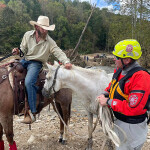Insect bite hypersensitivity (IBH) is an allergic dermatitis, or skin inflammation, most commonly caused by the bites of insects belonging to the genus Culicoides, specifically, biting midges, gnats, and flies. Although not life threatening, IBH can be a serious issue for equines that react to these tiny, bloodsuckers.
As the heat, and thus insect activity, ramps up in the mid-south, horse owners and caregivers need to be aware of the signs of IBH as well as ways to combat it.
IBH begins with a simple insect bite. The saliva of these insects then causes an allergic reaction at the bite site, and for some horses, extreme hypersensitivity at the site. Pruritus, or intense itching, then follows. You may notice shifting fence posts or round pen panels as your horse tries to satisfy the constant itching. Patches of rubbed off hair may stand out on trees in the pasture. The ears, belly, and topline (especially at the base of the tail) are commonly affected areas. If your horse suffers from IBH you may notice dermatitis and hives in addition to the pruritus and consequent hair loss. If you own or care for Welsh ponies, Icelandic, Shire, or other Northern European breeds, watch out for IBH as these breeds may be genetically predisposed to it.
There are two different types of IBH: type 1 occurs when an immediate reaction to a bite is seen; type 2 involves a delayed reaction. Regardless of which type of IBH your equine has, both cause the same aforementioned symptoms. One of the major risks with IBH is secondary infections. Due to the constant itching, your horse can create abrasive skin damage. Once the skin is opened, your horse is now at risk for infection. The hot, humid weather combined with open skin will only entice more insects to the site, thus exacerbating the condition.
Lichenification, or an area of thickened skin, is also a secondary threat associated with IBH. Chronic rubbing and itching causes irritation which results in additional skin cell growth. The cells combine and pile up to the point of creating a leathery or tree bark-like appearance on the horse’s skin.
Although it may be a struggle to fight IBH this summer, there is hope for those equestrians who own or ride horses suffering from this miserable condition. With your veterinarian’s help, a combative plan can be put into action. First, you may try a high-quality barrier cream. An antihistamine and/or corticosteroid containing topical ointment may provide your horse with some relief.
Another option to fight IBH is the use of mesh fly sheets and fly boots. These provide a physical barrier to keep biting insects off your equines. A fly sheet sprayed with insect repellant can offer an extra layer of protection. Remember: these options can have drawbacks as well. Some horses may become overheated while wearing a fly sheet in the summer months. Other horses’ skin may become even more irritated due to the rubbing of the fly sheet across sleek skin. If you do use fly sheets or fly boots this summer, be sure to remove them regularly and assess your horse for any areas of irritation these products may cause. Fly boots on the hind legs should be checked daily, as they can catch manure.
You may also consider combating biting insects from the inside out. Research shows equine diets supplemented with plant-based omega-3 fatty acids can decrease the inflammatory response. Feeding flaxseed may be associated with a significant decrease in reactivity to the Culicoides’ saliva as well. Targeted anti-inflammatory supplements are also on the market for horses with specific allergies and IBH.
Top-dressing your horse’s feed with apple cider vinegar (ACV) can also serve as a natural insect deterrent. Depending on the horse’s weight, try feeding ¼-½ cup of ACV daily. Dilute the vinegar with water, 50/50 and add to your horse’s usual feed. You can also drizzle ACV over the hay ration. Daily ingestion of ACV increases the level of thiamine (vitamin B1) excreted through the horse’s skin. In turn, this discourages all types of biting insects, including flies and mosquitoes. As always, check with your veterinarian before making any changes to your horse’s feeding routine.
If you have tried all the suggestions above and suspect your horse suffers from IBH, Megan Hunt, DVM, of Cornerstone Equine recommends having your horse allergy tested. If extreme hypersensitivity is detected through this testing, a serum can be created by a lab which is then used to treat your horse, via injection, in an attempt to adjust the horse’s immune system to tolerate the problem-causing allergens. The lab Dr. Hunt utilizes, Nextmune, even has regional-specific panels, which can specifically pinpoint which insects here in the mid-south are plaguing your equine.
For about six months a low concentration of the specific immunologic serum is given to your horse at an increased frequency until a maintenance level is reached. Then your horse will receive one injection per month for up to five years, depending on the horse and severity of its allergies. While not curable, Dr. Hunt explains the goal of these injections is to be able to treat equine allergies with “less medication and make the treatment more manageable.”










